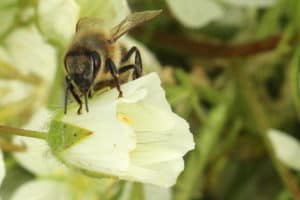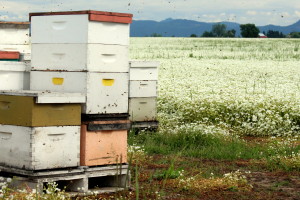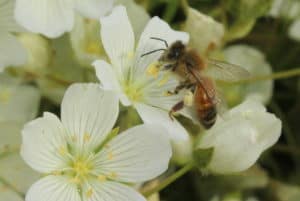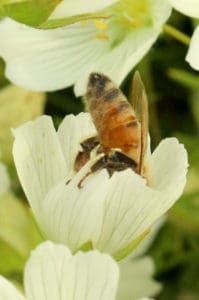
May in the Willamette Valley is a time of lush green fields of grazing pasture and grass seed crops covering the flatlands along the I-5 corridor from Eugene to Portland. These verdant fields are punctuated by small plantings of dense, low growing, brilliantly white flowers, appropriately called Meadowfoam. Meadowfoam (Limnanthes alba) is an annual oilseed crop with a native range from Vancouver Island, BC to northern California. The oil derived from Meadowfoam seeds contains long-chain fatty acids that are very stable relative to other vegetable oils. This resistance to degradation make it a valuable ingredient to prolong shelf life of products and it is of particular value to the cosmetic industry.

Meadowfoam pollen is heavy and sticky making it more suitable for insect pollination than wind pollination. Honeybee foragers are able to gather both pollen and nectar from Meadowfoam fields. The recommended stocking rate to maximize production is at least 3 strong colonies per acre. Saturation of pollinators is important to maximize pollination since individual flowers are only receptive to optimum pollination for a 24 hour window. During peak bloom 4-6 million new flowers per acre open on days with favorable weather. Meadowfoam is moderately attractive and there are many other coinciding blooms so it is recommended that colonies be brought in when 5-10% of Meadowfoam flowers are open to discourage bees from seeking competing blooms beyond the boundaries of the target field.

Meadowfoam flowers are self-fertile but they exhibit protrandy with pollen maturing before ovules are receptive to pollination. This offset in timing within individual flowers results in pollen from anthers of one flower being transferred to receptive stigma of another flower. Honeybees foraging for both pollen and nectar are able to accomplish this transfer inadvertently by visiting multiple flowers, with more visits to an individual flowers increasing seed yield. After pollination Meadowfoam is left to mature while seeds develop and the plant matures to a golden color. Meadowfoam is harvested in a similar manner to grass seed with the fields typically being cut and windrowed in late June. After a week of drying, seeds are separated with a combine with reported yields ranging from 400-1200 lbs/acre, with lower yields generally being attributed to poor weather during pollination.

Beekeepers that pollinate Meadowfoam harvest supers immediately after pollination to produce a high quality monofloral honey that is unique to the Willamette Valley and fetches a premium retail price at local markets. Meadowfoam honey is amber in color and has a very distinct ‘toasted marshmallow’ flavor that is unlike any other honey I’ve come across.
Further information about growing and pollinating Meadowfoam are available at these links. http://ir.library.oregonstate.edu/xmlui/bitstream/handle/1957/20038/em8666-e.pdf and http://arec.oregonstate.edu/oaeb/files/pdf/AEB0018.pdf